The Vikings, being the tough warriors they were, had a lot on their plate (literally!).
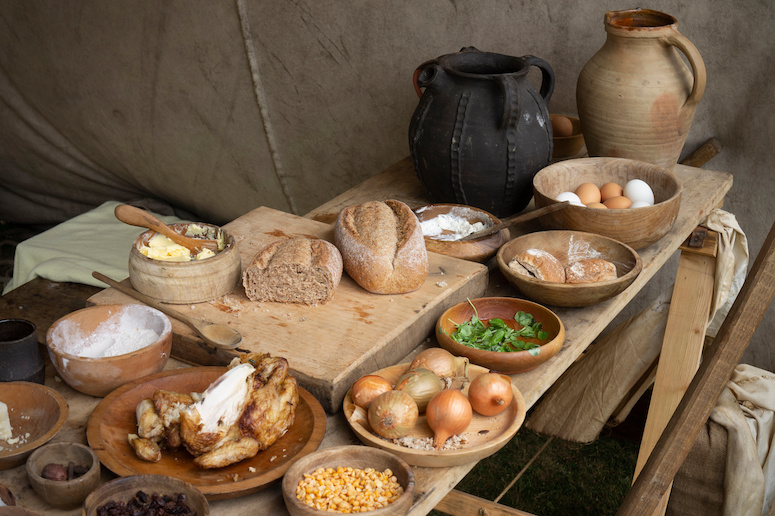
Imagine navigating the harsh northern landscapes, embarking on wild sea voyages, and facing off in epic battles. You’d need some serious strength and stamina for all that. That’s where their diet comes into play.
In recent years, interest in the Viking diet has surged as people around the globe seek inventive ways to improve their health and get in shape.
Rich in whole, unprocessed foods, the Viking diet, which sustained these ancient warriors, is now considered a potential model for modern nutrition.
But what did these ancient navigators consume to fuel their expeditions, and can their dietary choices guide us toward enhanced well-being today? Let’s find out!
How well did the Vikings eat?
When you think about a Viking feast, Hollywood and modern stories often depict massive tables filled with huge chunks of meat, horns of ale and all sorts of wild delicacies.
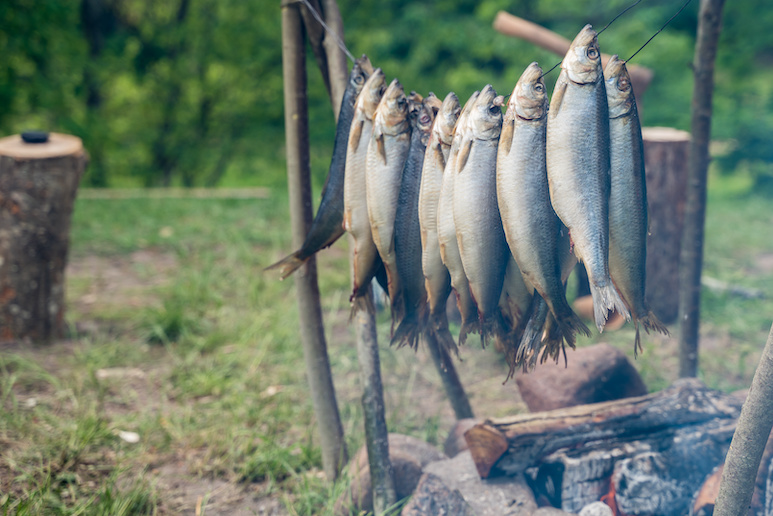
But let’s take a step back from that image. In reality, the Vikings lived in some pretty tough environments, which meant their dietary choices were a bit limited.
Viking lands weren’t the easiest for farming, so they had to make do with what was available. That included lots of fish (being seafarers and all), along with available grains, vegetables and some livestock.
This diet influenced not only their health but also their physical stature. For more on this, check out our post How tall were the Vikings?.
However, life and diet weren’t the same for every Viking. Like today, social status influenced what was on the dinner plate. Higher-class Vikings likely had a more diverse diet, while everyday Vikings ate simpler fare.
Comparing their diet to other societies of the time, such as the Anglo-Saxon kingdoms of modern-day Britain, the Viking diet was probably similar in many ways. It was a tough era, and everyone had to make do with what the land and seasons provided.
Even then, the Vikings were pretty resourceful with their food, making the most out of what they had to stay strong and ready for their many adventures.
So what did the Vikings actually eat?
Meat
Meat was always on the VIking menu. No matter if you were a top-notch warrior or a simple farmer, meat was for everyone, every day.
Pork was the most common, but the Vikings also ate beef, mutton, goat, and yes, even horses.
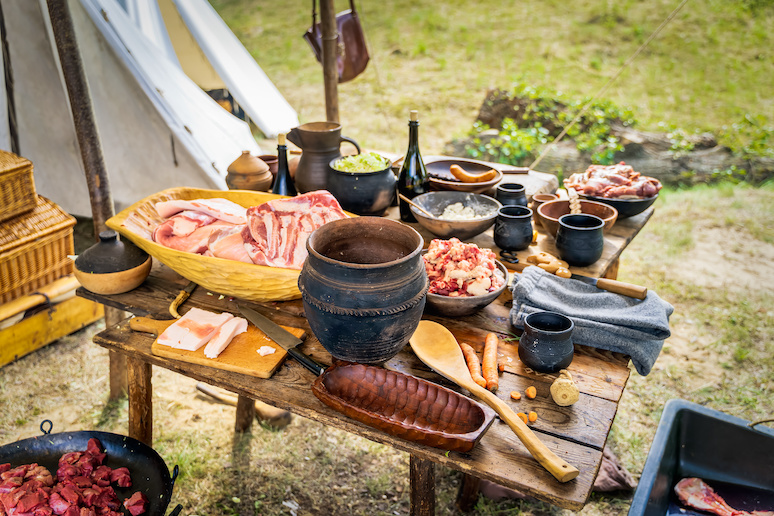
Hunting was pretty important too – most Vikings could bring down a massive elk or a speedy reindeer. And bear was also on the menu at times. This not only provided food but also a serious workout!
And let’s not forget about fish. Being masters of the sea, fish, especially herring, had a special place on the Viking dinner table. They had all sorts of clever ways to prepare it, from drying to fermenting (and this may have been a precursor to Sweden’s famously smelly surströmming).
Now, about eating horses. It was kind of a big deal. While horse meat was a normal part of the Viking diet, it clashed with the Christian beliefs that began to proliferate towards the end of the Viking Age.
In fact, eating horse was made taboo by a papal decree before the Viking Age started. And so as Christian and Viking cultures mixed, it’s safe to assume there were some ideological differences about eating horse meat.
Vegetables and fruit
It wasn’t all about the meat and fish – Vikings also had their fair share of veggies and fruit. But think wild and rustic rather than the polished produce we see today.
They munched on white carrots, cabbages, beans, peas and endive. Pretty hearty stuff that could stand up to their harsh climate.
For a sweet treat, they would forage for wild apples and berries, adding a burst of flavour to their meals. And let’s not forget about the zing from seasonings and spices.
They used coriander, cumin, mustard and wild horseradish to add some kick to their dishes. So, while their diet was hearty and robust, it definitely wasn’t bland!
Dairy and fermented foods
Dairy was another crucial part of the Viking diet. Think hearty cheeses, creamy butter and various fermented milk products.
These foods provided essential nutrients, helping the Vikings keep up their energy and strength for their daily toil and epic voyages.
Fermented foods were a smart and necessary choice for the Vikings. They knew how to preserve food in a way that not only kept it edible but also enhanced its health benefits.
Fermentation added good bacteria, or probiotics, into their diet, aiding digestion and boosting immunity.
Drinks
Now, what were the Vikings washing all that hearty food down with? The evidence shows that beer and mead were the drinks of choice.
Beer was usually a staple at meals, while mead, a fermented drink made from honey, water, and various fruits, grains, hops, and spices, was a sweet treat for special occasions.
For a deeper dive into Viking drinking habits, check out our post on What did Vikings drink? It’s filled with insight into the beverages that kept the Vikings hydrated (or, well, maybe a bit more than hydrated!) as they navigated their rugged world.
Cooking techniques
When it came to cooking, Vikings kept things pretty straightforward.
Boiling was the go-to method rather than roasting or frying. One popular dish was skause, a boiled meat stew that was probably as hearty as it gets.
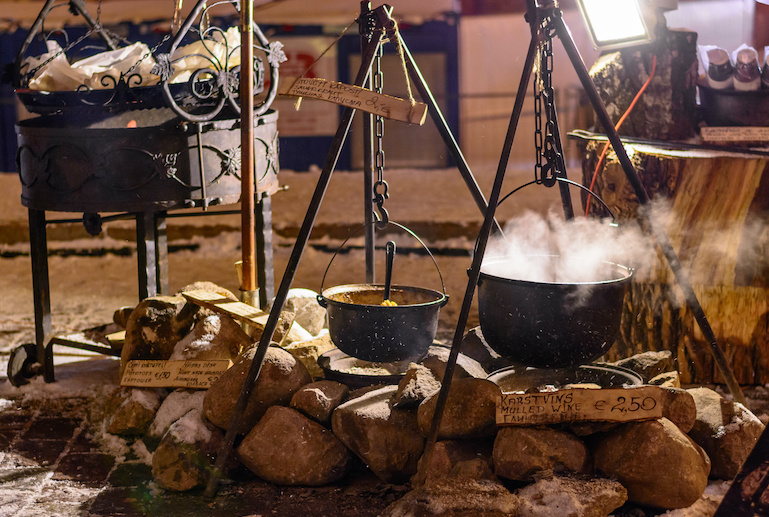
And don’t forget about the bread! Vikings had their own versions made with grains, beans and even tree bark like birch. Yep, tree bark. They were all about using what was around them.
They also knew the secrets of sourdough, which means their bread was not just filling, but fermented and good for the gut too.
All in all, Viking cooking was all about simplicity, resourcefulness and packing in the nutrients to fuel their tough lives.
The pros and cons of eating like a Viking
Pros
- A diverse range of foods. The Vikings’ diverse menu meant loads of different nutrients. They got a wide variety of goodies from their food, keeping them ready for action.
- Fresh and natural fare. No weird preservatives or chemicals here! Just fresh, natural ingredients straight from the land and sea.
- Unconventional nutrition. Ever think about eating birch bark? The Vikings did, and it added some extra nutrition to their diet.
- Macro and micronutrients. Their diet was rich in both macro and micronutrients, contributing to overall health and vitality.
- A balanced diet. With a good mix of proteins, healthy fats and complex carbs, the Vikings had a well-rounded diet to fuel their adventurous lives.
Cons
- Parasitic infections. Archaeological findings show signs of parasitic infections in Vikings, such as intestinal worms.
- High meat content. A diet heavy in red meat, without today’s knowledge about cholesterol and heart health, may have had its downsides, even for these rugged warriors.
So should you switch to a Viking diet?
Wondering if it’s time to eat like a Viking? Let’s chew on this for a bit. Today’s experts would high-five the Vikings for eating fresh, unprocessed foods – no weird chemicals or mystery ingredients, just real, straight-up food.
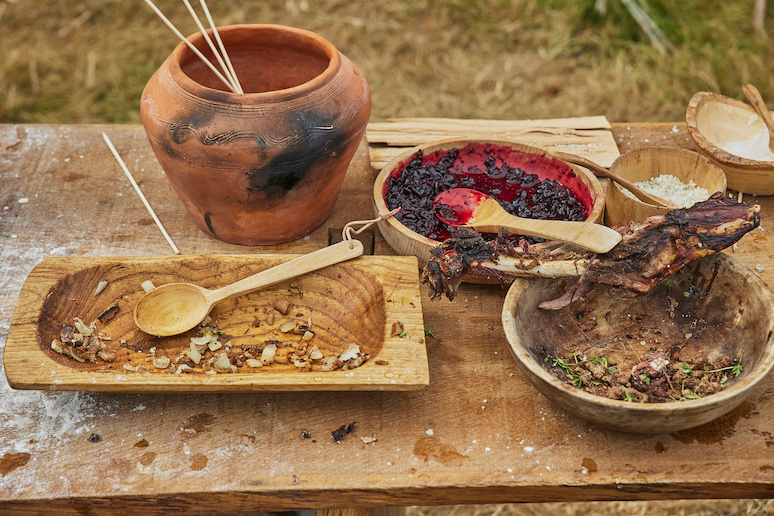
But, on the flip side, there’s the high meat intake and some unconventional, and sometimes risky, ingredients (tree bark, anyone?).
How does it stack up against today’s diets? It shares some similarities with the Paleo and Keto diets, focusing on whole foods and lots of proteins.
However, unlike Keto, the Viking diet also included a good amount of whole grains and various protein sources beyond just meat.
The fresh, diverse ingredients? Good. But some choices might raise an eyebrow or two today.
If you’re keen, maybe snag the best parts of the Viking diet and mix it with what we know now. That way, you can feast like a Viking but with a modern twist.
Adopting a Viking diet
Thinking about taking the plunge and adopting a Viking-style diet? Here’s a game plan.
Start with fresh, local produce and unprocessed meats and fish. For modern equivalents, think root veggies, hearty greens and sustainably sourced meats and seafood.
Considering a “Viking Diet Challenge”? Picture this: A month of eating only fresh, unprocessed foods, embracing lean proteins, whole grains and foraged or seasonal fruit and veg. But, as with any diet, it’s essential to weigh potential health benefits against any concerns.
Exploring the New Nordic Diet (NND), which is similar to the Viking diet, a study by Sanne Kellebjerg Poulsen et al sheds light on its long-term impact.
Despite initial weight loss, after 26 weeks on the NND, participants’ commitment waned, leading to an average weight regain of 4.6 kg over a year.
However, those who diligently followed the NND guidelines regained less weight. Increasing physical activity further enhanced the results, leading to even lesser weight regain.
In a nutshell, while the Viking-like NND isn’t a miracle fix, consistent adherence and added physical activity can make it a viable path to sustained health and weight management.
A Viking-inspired recipe to try at home
Viking-inspired lamb stew with root vegetables
This dish melds the robust and hearty flavours of the Viking diet with modern cooking techniques.
Lamb, root vegetables and barley were all staples of the Viking diet, making this a meal that a Viking might have enjoyed after a long day of work or adventure.
Ingredients:
- 500g (1lb) lamb chunks, preferably from the shoulder
- 3 large carrots, roughly chopped (use white or purple carrots if available)
- 2 parsnips, roughly chopped
- 1 turnip, diced
- 1 onion, diced
- 3 cloves garlic, minced
- 1 liter (4 cups) beef or vegetable broth
- 2 tablespoons vegetable or olive oil
- Salt and freshly ground black pepper, to taste
- 1 teaspoon dried thyme (or fresh if available)
- 2 bay leaves
- 200g (1 cup) barley or other ancient grains
- A handful of fresh parsley, chopped
- 1 tablespoon apple cider vinegar
Instructions:
- Searing the lamb: In a large pot or Dutch oven, heat the oil over medium-high heat. Season the lamb chunks with salt and pepper. Add them to the pot in batches, ensuring not to crowd the pot. Sear until they are brown on all sides. Remove the lamb and set it aside.
- Cooking the vegetables: In the same pot, add the diced onion. Sauté until translucent, then add the garlic. Cook for another 1–2 minutes. Add the chopped carrots, parsnips and turnip to the pot. Stir and sauté for about 5 minutes.
- Building the stew: Return the seared lamb to the pot. Add in the beef or vegetable broth, ensuring that the liquid covers the meat and vegetables. Throw in the thyme and bay leaves.
- Simmering: Reduce the heat to low, cover the pot, and let it simmer for about 1.5 hours. Check occasionally to ensure that the stew doesn’t dry out; if necessary, add more broth or water.
- Adding barley: After 1.5 hours, add the barley to the pot. Stir well and continue to simmer for another 30 minutes, or until the barley is cooked through and the lamb is tender.
- Finishing touches: Once the stew is done, stir in the apple cider vinegar and chopped parsley. Check for seasoning and add salt and pepper if needed.
- Serving: Serve hot, preferably with a side of sourdough bread or flatbread.
See also:
Viking longhouses: the ultimate guide
Viking chess explained
Viking runes revealed: what they really mean









